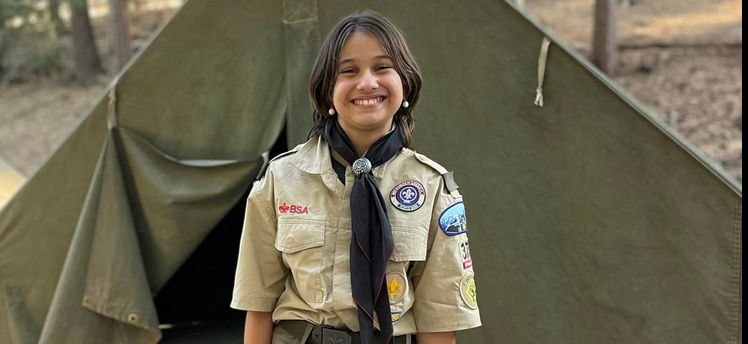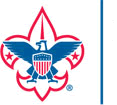Gear + Uniforms

Class “A” Uniforms:
Class A (officially known as the “Field Uniform“) uniform is the button up tan shirt with patches, troop neckerchief with woggle, olive green scout pants/shorts, belt, and socks.
- The Class A uniform is worn to meetings, Scoutmaster Conferences, Board of Review, and any ceremonies.
- When traveling to and from outings all that is required is the Class A shirt without the neckerchief or woggle.
- “Summer Class A Uniform”: The neckerchief and woggle are not worn in the Summer (between Memorial Day and Labor Day) with the exception of formal parades or events.
The Troop “Full Field Uniform” (often referred to as “Class A”) includes a long or short sleeve Scout shirt with appropriate insignia, Troop neckerchief, Scout pants (long or short), belt, socks and neckerchief slide. Each Scout is expected to wear her complete uniform and neckerchief to all Troop meetings, while traveling with the Troop on official outings (excluding the neckerchief and slide), and as announced for special events. Troop rules mandate that the Full Field Uniform, including neckwear be worn at the Scoutmaster Conference, the Board of Review, and at Troop Committee presentations at Courts of Honor. The Troop neckerchief should be worn in place of any BSA neckwear at all Courts of Honor. (Note: Order of Arrow sash should be worn at OA sponsored events, special Scouting activities, including Courts of Honor, and on special occasions when members need to be identified as Arrowmen rendering special services.) During Summer months, between Memorial Day and Labor Day, Scouts may omit wearing the neckerchief and slide).
Shoes: Tennis shoes may be worn to Scout Meetings, at Summer Camp, and on warm weather campouts. Each Scout should possess a sturdy pair of outdoor shoes, which are suitable for rough use and for hiking. Shoes should be large enough to wear a thick wool sock over a thin wicking sock (polypropylene, silk, wool, etc.). Two socks serve to cushion the foot and will help reduce the possibility of blistering. Shoes should be waterproofed and weather appropriate.
Class “B” Uniforms:
Class B (officially known as the “Activity Uniform“) is any BSA themed shirt.
Chits:
A Scout will earn “Chits” or certificates for carrying a knife or tending a fire. The Scout needs to have these cards on them when carrying any knife or starting/tending a fire.
From experience, the Scout usually carries these in his pocket. The cards will get wet from being in the rain, swimming, sweating, or washed in the laundry. Laminate the Totin’ Chip and Fireman’s Chit cards. Office Depot or Staples or any copy store can do this. This will make them last a lot longer.
What Gear do I need?
Chapters 8 and 9 of the Scout Handbook describe Hiking and Camping and include checklists and information for Gear and Equipment. If a Scout needs gear for outings, ask some of the other Scouts or the Troop if they have extra gear to loan out (we sometimes do).
Personal Gear for Camping (Recommended)
Backpack: The preferred, hands free method for carrying gear. Good backpacks have many pockets for organizing, and straps for attaching a sleeping bag, pad and tent. Limited capacity will teach the Scout to prioritize her packing and minimize bulk and weight. There is a wide range of products and prices available on the market, so take time to shop for both comfort and price. If cost is prohibitive, duffel bags or similar gear are acceptable for campouts that do not include overnight hikes.
Sleeping Bag: Bags are constructed from a wide variety of materials to satisfy a variety of weather, packing, weight and price requirements. Sleeping bags which can be packed into a stuff sack are more convenient than rolled bags with ties. You should avoid cotton bags and select one made with synthetic insulated materials. Look for a full-length zipper, batting in the lining which insulates the zipper, and the amount of quilting used to prevent the insulation from bunching or sagging. A bag insulated for a comfort range down to 20 degrees is highly recommended. For winter camping, 20-degree bags may be nested into a second bag for additional comfort, avoiding the higher cost associated with bags rated for below 0 degrees. Remember, a Scout is prepared…and thrifty!
Ground Pad: Scouts will find sleeping on the ground more comfortable and warmer when a “closed cell” pad is used under the sleeping bag. These pads are made from a heavy rubber like foam 3/8” to 1/2” thick, and approximately 24” wide by 72” long. They roll up compactly, are easily carried on the backpack, and are more comfortable, warmer and less of a nuisance than an air mattress. An alternative is a self-inflating pad, which is a foam pad inside a waterproof covering. These are about 1/2” to 3/4” thick when inflated, and the same length and width as most closed cell pads.
Rain Suit/Poncho: Scouts must be fully prepared to carry on with our outdoor program, regardless of weather conditions. Good rain gear is essential for both comfort and safety. Avoid the thin, emergency type ponchos typically sold in store checkout lines.
Mess Kit: It’s not necessary to purchase a traditional mess kit. Pieces may be lost or broken, leaving the set incomplete. In substitution, Scouts may use plastic plates, bowls and mugs. These are lightweight and can be easily marked for identification. Mismatched silverware is also a useful substitute.
Plastic or aluminum water bottle or canteen: Each Scout must carry 1.5 to 2 quarts of water on hikes and backpacking outings. One or more water bottles that fit into a pocket of the backpack or in a hip pack are acceptable. Water is an essential item and required for all BSA and Troop activities.
Knives: Once a Scout has earned his “Totin’ Chip” card, he may carry a folding pocket knife of a size approved by BSA. Troop 373G prohibits carrying sheath knives of any kind at all Scouting activities. The card must be carried with the knife as evidence of the Scout’s training in knife safety.
Compass: Every Scout must have a compass for practicing the orienteering skills needed to pass Second Class and First Class rank advancements. Her compass should be with her on all campouts as a camping essential.
Whistle: Scouts must carry a whistle. These are used for communication only, and can save a life in the event of an emergency. This is another essential item, to be carried at all times.
Online Stores and Uniform Guidelines
- Scout Stuff – The Official BSA retail store
- Campmor – Camping equipment at great prices. Ships fast.
- Scout Uniform Inspection Form – Scout Uniform Inspection Form and Badge/patch placement guide
- Adult Scout Uniform Inspection Form – Adult Uniform Inspection Form and patch placement guide


